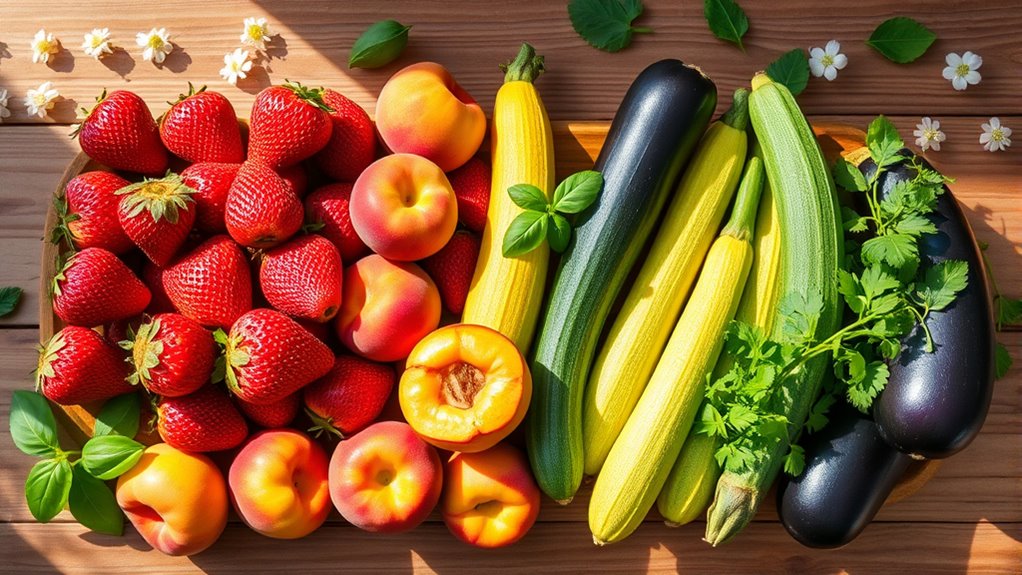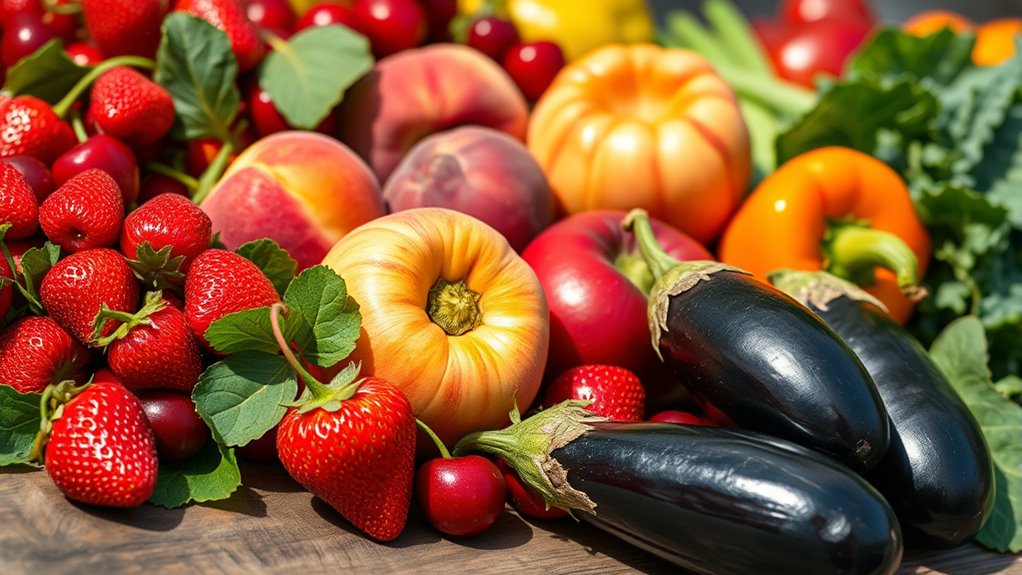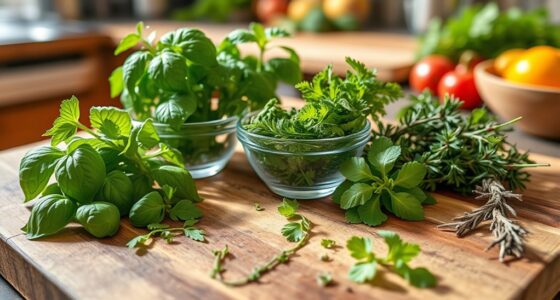A seasonal eating planner helps you stay on top of what fruits and vegetables are freshest each month. By knowing what’s in season, you can enjoy peak flavor, save money, and reduce waste. For example, berries and cherry tomatoes shine in summer, while apples and root vegetables are best in fall. Keeping this schedule in mind makes meal planning easier and more intentional. Keep exploring to discover tips that will help you make the most of seasonal produce year-round.
Key Takeaways
- Create monthly shopping lists based on the seasonal produce calendar for optimal freshness and flavor.
- Focus on peak fruits and vegetables like berries in summer and apples in fall for best nutrition.
- Incorporate frozen produce for off-season options, ensuring year-round access to seasonal flavors.
- Use seasonal produce guides to plan meals that align with what’s naturally available each month.
- Adjust recipes and meal plans monthly to maximize freshness, taste, and nutritional value of seasonal ingredients.

A seasonal eating planner helps you align your meals with the freshest and most flavorful produce throughout the year. When you plan ahead, it becomes easier to enjoy fruits and vegetables at their peak, which means better taste and more nutrients. One key aspect of this is understanding what’s in season each month. For example, cherry tomatoes and berries are best in summer, while root vegetables and apples shine in fall. By knowing what’s ripe and available, you can make smarter grocery shopping choices and avoid buying produce that’s out of season or less flavorful.
Using a seasonal eating planner also encourages you to explore frozen produce options. Freezing fruits and vegetables at their peak preserves their flavor and nutrients, making it a great backup when fresh items aren’t available or are more expensive. Frozen produce can be just as nutritious as fresh, especially if you’re mindful of choosing options without added sugars or preservatives. Incorporating frozen items into your meals allows you to enjoy seasonal flavors year-round, even when certain produce is out of season locally. This flexibility makes meal planning more convenient and reduces waste, since you can buy in bulk and store what you don’t use immediately.
Grocery shopping tips are essential to making the most of your seasonal eating plan. Always start with a list based on what’s in season, which helps you avoid impulse buys and ensures you focus on fresh, affordable options. When shopping, look for signs of freshness—vibrant color, firmness, and minimal blemishes. Don’t hesitate to ask store staff about the freshest items or the best time to buy certain produce. If you’re unsure whether to buy fresh or frozen, consider your schedule and storage options. Frozen produce is a smart choice if you want convenience or if an item isn’t available fresh. It’s also budget-friendly, often cheaper than fresh, especially for out-of-season produce.
Incorporating seasonal eating habits into your routine also means being flexible and creative. When certain fruits or vegetables are in abundance, find new recipes or ways to prepare them. This not only keeps meals interesting but also helps you get the most flavor and nutrition. Keep your pantry stocked with frozen produce, so you’re always ready to whip up a healthy dish, regardless of the season. This approach not only saves money but also reduces food waste and supports sustainable eating habits. Planning around what’s fresh each month, using frozen options, and following grocery shopping tips ensures you get the most out of each season, making your meals more vibrant, nutritious, and enjoyable all year long. Additionally, understanding juice extraction techniques can help you maximize nutrient intake from seasonal fruits and vegetables, enhancing your overall diet.
Frequently Asked Questions
How Can I Find Local Farmers’ Markets for Seasonal Produce?
You can find local farmers’ markets by searching online for nearby options or checking social media. Visit CSA programs and farm stands in your area, as they often sell seasonal produce directly from farmers. Additionally, local community boards or city websites usually list farmers’ markets. Don’t forget to ask neighbors or friends for recommendations—word of mouth can lead you to hidden gems offering fresh, seasonal foods right in your community.
Are There Specific Storage Tips for Seasonal Fruits and Vegetables?
Think of your seasonal fruits and vegetables as treasures needing the right preservation techniques. To keep produce fresh, store berries in breathable containers, and keep root vegetables in a cool, dark place. I once kept tomatoes in a paper bag, and they ripened perfectly. Use proper storage containers to prevent spoilage and extend freshness. Remember, each type has its ideal storage method—invest a little time for delicious, lasting harvests.
How Can I Adapt Recipes to Seasonal Ingredients I Find Locally?
When adapting recipes to seasonal ingredients you find locally, start with cooking substitutions that highlight their natural flavors. Use simple techniques like roasting or steaming to enhance taste and preserve freshness. Don’t forget flavor enhancements—adding herbs, spices, or a splash of citrus can elevate your dish. Trust your taste buds; experimenting with these adjustments helps you create delicious, seasonally inspired meals that celebrate what’s fresh and available.
What Are Some Affordable Seasonal Eating Options for a Tight Budget?
Irony strikes—you can save money by eating seasonally! For budget-friendly swaps, focus on local, in-season produce, which is often cheaper and fresher. Use meal planning tips to maximize ingredients and reduce waste. Think root vegetables in winter and greens in spring. Shopping at farmers’ markets or discount stores also helps. Embrace seasonal eating, and your wallet will thank you as much as your taste buds.
How Does Eating Seasonally Impact My Environmental Footprint?
Eating seasonally helps reduce your environmental footprint by supporting sustainable farming practices. When you choose locally grown, in-season produce, you’re cutting down on transportation emissions and energy use. Additionally, you may adopt composting practices that minimize waste and enrich the soil. Together, these actions promote a healthier planet, lower your carbon footprint, and encourage a more sustainable lifestyle.
Conclusion
By following this seasonal eating planner, you’ll always have fresh, flavorful produce at your fingertips. Embrace the rhythm of nature and enjoy the bounty each month offers. Remember, variety is the spice of life, so don’t be afraid to try new ingredients as they come into season. When you eat with the seasons, you’re not just nourishing your body—you’re also supporting local farmers and reducing your carbon footprint. It’s a win-win situation!









